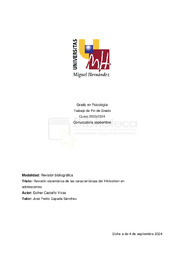Please use this identifier to cite or link to this item:
https://hdl.handle.net/11000/33619Full metadata record
| DC Field | Value | Language |
|---|---|---|
| dc.contributor.advisor | Espada Sánchez, José Pedro | - |
| dc.contributor.author | Castaño Vivas, Esther | - |
| dc.contributor.other | Departamentos de la UMH::Psicología de la Salud | es_ES |
| dc.date.accessioned | 2024-10-23T09:36:50Z | - |
| dc.date.available | 2024-10-23T09:36:50Z | - |
| dc.date.created | 2024-09 | - |
| dc.identifier.uri | https://hdl.handle.net/11000/33619 | - |
| dc.description.abstract | El hikikomori es un fenómeno desconocido que está cogiendo cada vez más fuerza ya no solo en Asia, sino también en Europa y el resto de los continentes. Entendemos por hikikomori el aislamiento social, extremo y voluntario que se da especialmente en la población adolescente. La presente revisión bibliográfica nace con el objetivo de unificar y agrupar las diferentes características del Hikikomori en la adolescencia. Con el objetivo de garantizar la mejor recopilación de datos se ha seguido la declaración PRISMA 2020 obteniendo un total de 145 artículos obtenidos mediante las bases de datos Web of Science, Scopus y PubMed. Se han seleccionado 10 artículos para su inclusión en este trabajo que han posibilitado la inclusión de 26 características de los adolescentes con hikikomori. Se ha evidenciado la falta de investigación del fenómeno en la adolescencia, especialmente en España. En consecuencia, se ha concluido que se necesita más investigaciones científicas para poder mejorar la salud de los adolescentes con hikikomori y poder realizar una detección precoz. | es_ES |
| dc.description.abstract | Hikikomori is an unknown phenomenon that is gaining momentum not only in Asia, but also in Europe and other continents. We understand hikikomori as the extreme and voluntary social isolation that occurs especially in the adolescent population. The present bibliographical review was created with the aim of unifying and grouping together the different characteristics of Hikikomori in adolescence. In order to guarantee the best data collection, the PRISMA 2020 statement has been followed, obtaining a total of 145 articles obtained from the Web of Science, Scopus and PubMed databases. Ten articles were selected for inclusion in this study, which made it possible to include 26 characteristics of adolescents with hikikomori. The lack of research on the phenomenon in adolescence, especially in Spain, has become evident. Consequently, it has been concluded that more scientific research is needed to improve the health of adolescents with hikikomori and to be able to carry out early detection. | es_ES |
| dc.format | application/pdf | es_ES |
| dc.format.extent | 25 | es_ES |
| dc.language.iso | spa | es_ES |
| dc.publisher | Universidad Miguel Hernández de Elche | es_ES |
| dc.rights | info:eu-repo/semantics/openAccess | es_ES |
| dc.rights | Attribution-NonCommercial-NoDerivatives 4.0 Internacional | * |
| dc.rights.uri | http://creativecommons.org/licenses/by-nc-nd/4.0/ | * |
| dc.subject | hikikomori | es_ES |
| dc.subject | adolescencia | es_ES |
| dc.subject | revisión sistemática | es_ES |
| dc.subject | aislamiento | es_ES |
| dc.subject | adolescence | es_ES |
| dc.subject | systematic review | es_ES |
| dc.subject | isolation | es_ES |
| dc.subject.other | CDU::1 - Filosofía y psicología::159.9 - Psicología | es_ES |
| dc.title | Revisión sistemática de las características del Hikikomori en adolescentes | es_ES |
| dc.type | info:eu-repo/semantics/bachelorThesis | es_ES |

View/Open:
Memoria TFG Esther Castaño Vivas.pdf
561,79 kB
Adobe PDF
Share:
Admin Tools
.png)
